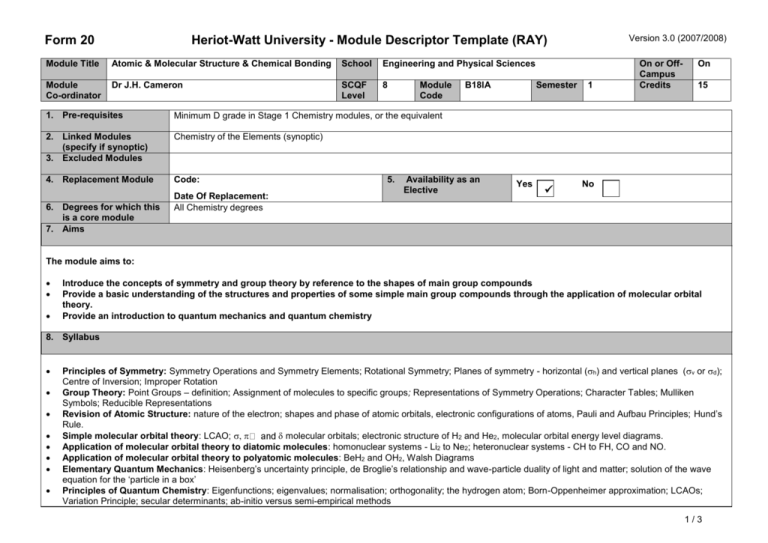B18IA - Atomic and Molecular Structure and Chem Bonding
advertisement

Form 20 Version 3.0 (2007/2008) Heriot-Watt University - Module Descriptor Template (RAY) Module Title Atomic & Molecular Structure & Chemical Bonding School Engineering and Physical Sciences Module Co-ordinator Dr J.H. Cameron SCQF Level 8 Module Code 1. Pre-requisites Minimum D grade in Stage 1 Chemistry modules, or the equivalent 2. Linked Modules (specify if synoptic) 3. Excluded Modules Chemistry of the Elements (synoptic) 4. Replacement Module Code: 6. Degrees for which this is a core module 7. Aims Date Of Replacement: All Chemistry degrees 5. B18IA Availability as an Elective Semester Yes 1 On or OffCampus Credits On 15 No The module aims to: Introduce the concepts of symmetry and group theory by reference to the shapes of main group compounds Provide a basic understanding of the structures and properties of some simple main group compounds through the application of molecular orbital theory. Provide an introduction to quantum mechanics and quantum chemistry 8. Syllabus Principles of Symmetry: Symmetry Operations and Symmetry Elements; Rotational Symmetry; Planes of symmetry - horizontal (h) and vertical planes (v or d); Centre of Inversion; Improper Rotation Group Theory: Point Groups – definition; Assignment of molecules to specific groups; Representations of Symmetry Operations; Character Tables; Mulliken Symbols; Reducible Representations Revision of Atomic Structure: nature of the electron; shapes and phase of atomic orbitals, electronic configurations of atoms, Pauli and Aufbau Principles; Hund’s Rule. Simple molecular orbital theory: LCAO; molecular orbitals; electronic structure of H2 and He2, molecular orbital energy level diagrams. Application of molecular orbital theory to diatomic molecules: homonuclear systems - Li2 to Ne2; heteronuclear systems - CH to FH, CO and NO. Application of molecular orbital theory to polyatomic molecules: BeH2 and OH2, Walsh Diagrams Elementary Quantum Mechanics: Heisenberg’s uncertainty principle, de Broglie’s relationship and wave-particle duality of light and matter; solution of the wave equation for the ‘particle in a box’ Principles of Quantum Chemistry: Eigenfunctions; eigenvalues; normalisation; orthogonality; the hydrogen atom; Born-Oppenheimer approximation; LCAOs; Variation Principle; secular determinants; ab-initio versus semi-empirical methods 1/3 Form 20 Version 3.0 (2007/2008) Heriot-Watt University - Module Descriptor Template (RAY) Module Title Atomic & Molecular Structure & Chemical Bonding School Engineering and Physical Sciences Module Co-ordinator Dr J.H. Cameron SCQF Level 8 Module Code B18IA Semester 1 On or OffCampus Credits On 15 9. Learning Outcomes (HWU Core Skills: Employability and Professional Career Readiness) Subject Mastery Understanding, Knowledge and Cognitive Skills Scholarship, Enquiry and Research (Research-Informed Learning) On completion of this module, the learner will be able to: Demonstrate knowledge and understanding of concepts and principles of elementary quantum mechanics Consider critically the application of quantum chemistry to the molecular structure and bonding Use fundamental principles to solve both qualitative and numerical problems Display a critical understanding of the concepts, theories and principles discussed in the module Integrate previous knowledge from across all of chemistry with the topics discussed in the module Analyse, evaluate and interpret experimental evidence of chemistry Recognise the range of symmetry operations and elements and to be able to identify them within a wide range of molecules Assign point groups to molecules and understand and be able to interpret character tables Set up reducible representations and from these produce irreducible representations Demonstrate a knowledge of atomic configurations, the rules governing these as well as the underlying physical concepts underpinning these rules Demonstrate an understanding of simple molecular orbital theory Apply molecular orbital theory to the electronic structure of homo- & hetero-diatomic molecules & some simple triatomic molecules Relate the electronic structure of these molecules to their physical properties. Personal Abilities Industrial, Commercial & Professional Practice Autonomy, Accountability & Working with Others Communication, Numeracy & ICT Personal abilities are embedded in the module. The module provides the opportunity to : Demonstrate problem-solving skills and the ability to critically evaluate ideas and information Manage time effectively, work to deadlines and prioritise workloads Communicate complex ideas and information effectively to a group of peers Use ICT skills with on-line materials, assessments (formative and summative) and web links to support the learning process Apply strategies for appropriate selection of relevant information from a wide source and large body of knowledge Practise the use of standard methods in the solution of routine chemical problems within familiar contexts Exercise some initiative and independence in carrying out defined activities Critically use mathematical methods to analyse various chemical spectroscopy variables Interpret, use and evaluate a wide range of data to solve problems of both a fundamental and analytical nature Evaluate numerical and graphical data and apply them to the solution of chemical problems Manage resources in defined areas of activity Work with peers in small groups in the discussion of chemical problems 10. Assessment Methods 11. Re-assessment Methods Method Duration of Exam (if applicable) Weighting (%) Synoptic modules? Method Duration of Exam (if applicable) 2/3 Form 20 Version 3.0 (2007/2008) Heriot-Watt University - Module Descriptor Template (RAY) Module Title Atomic & Molecular Structure & Chemical Bonding School Engineering and Physical Sciences Module Co-ordinator Dr J.H. Cameron SCQF Level 8 Synoptic Examination Class test Continuous Assessment Laboratory Work 12. Date and Version Date of Proposal 27 August, 2007 3h 2h Date of Approval by School Committee 50% 15% 15% 20% Module Code B18IB B18IA Semester 1 Synoptic Examination (100%) Date of Implementation 15 September, 2008 On or OffCampus Credits On 15 3h Version Number 1.0 3/3











